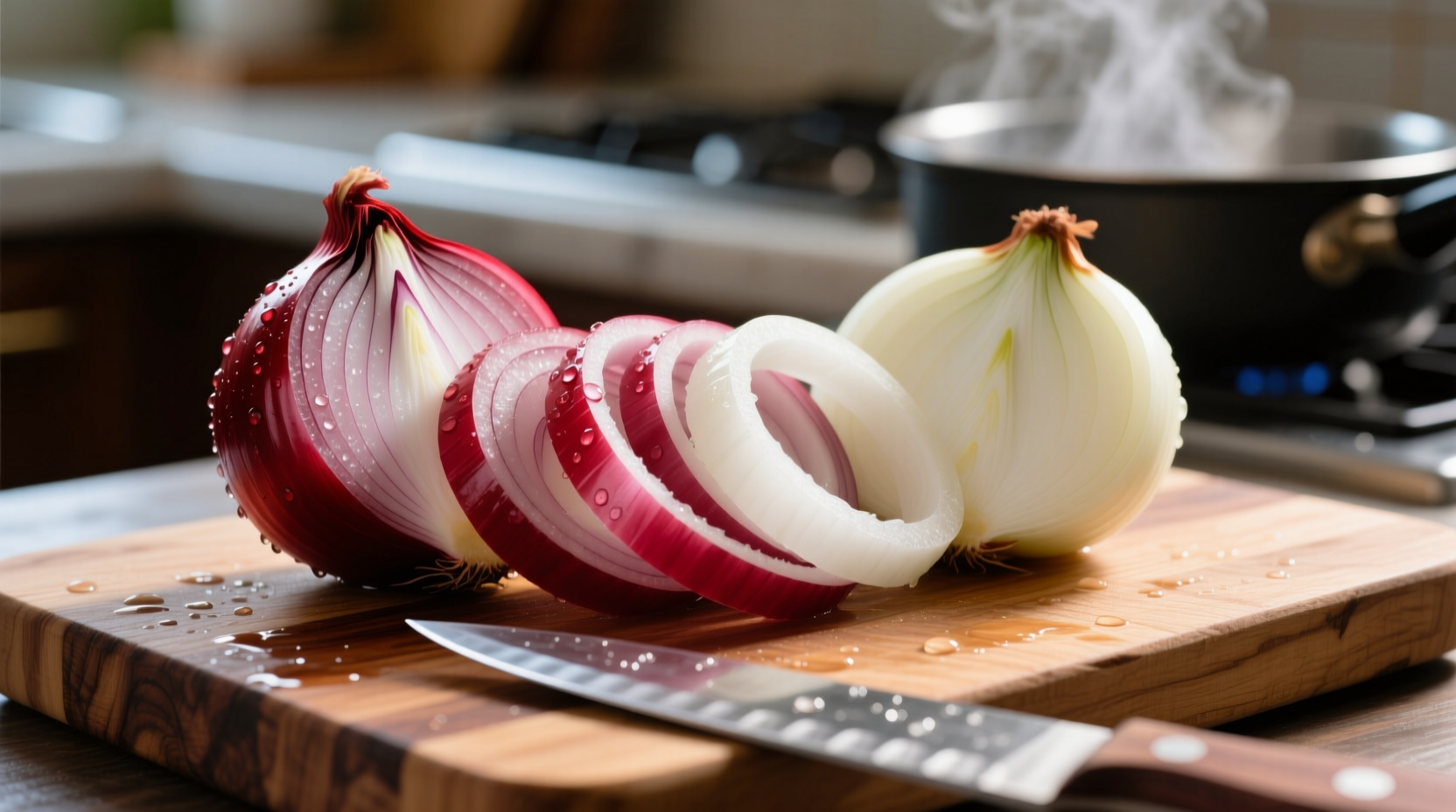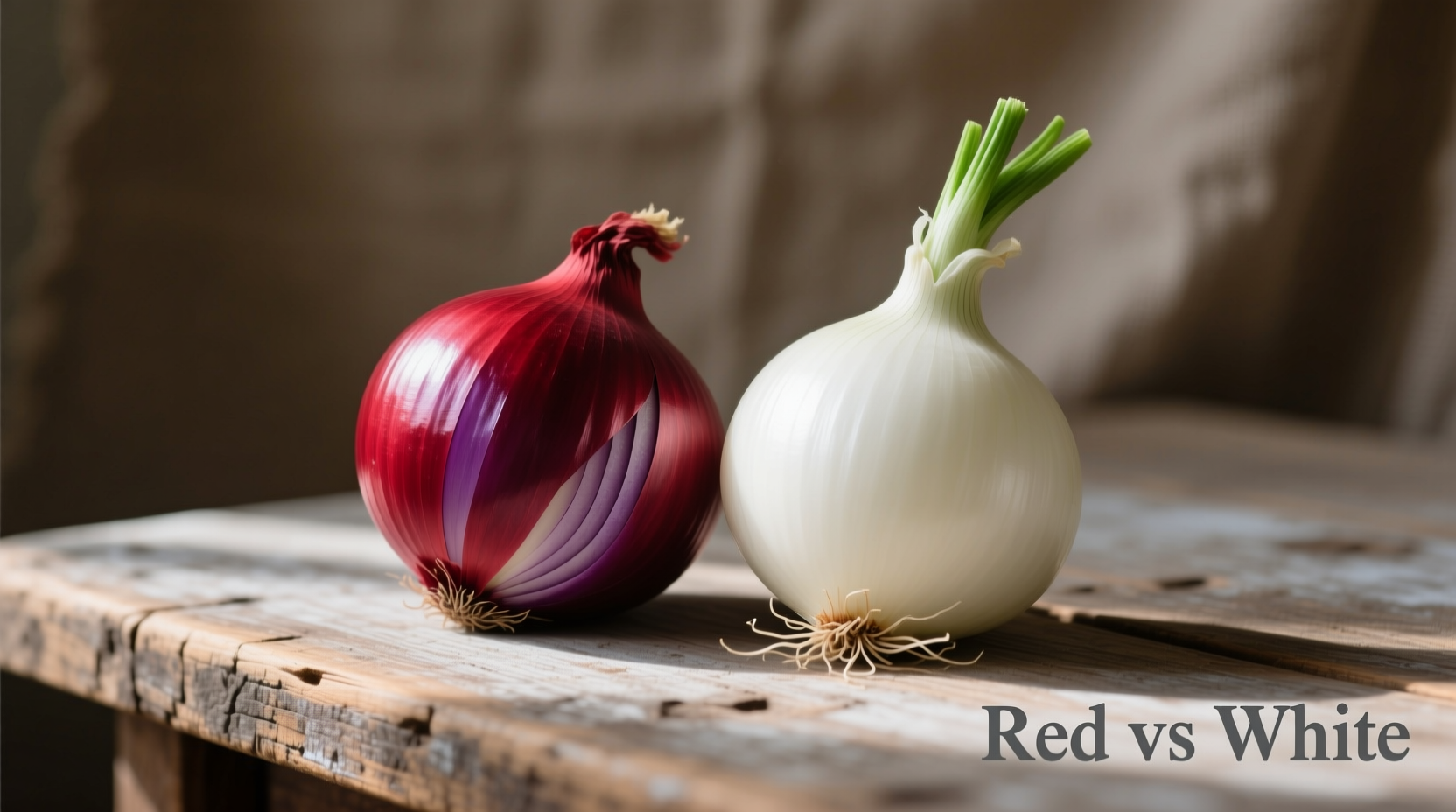Red onions have a stronger, spicier flavor with vibrant purple skin and white flesh tinged with red, making them ideal for raw applications like salads and salsas. White onions offer a sharper, more pungent bite when raw but mellow beautifully when cooked, with crisp white flesh perfect for Mexican cuisine, caramelizing, and grilling.
| Characteristic | Red Onion | White Onion |
|---|---|---|
| Flavor Profile (Raw) | Mildly sweet with noticeable peppery bite | Sharper, more pungent, intense sulfur notes |
| Flavor Profile (Cooked) | Becomes milder, slightly sweet | Develops rich sweetness, less bitter after cooking |
| Texture | Slightly softer, more moisture | Firmer, crisper texture |
| Best Culinary Uses | Salads, salsas, sandwiches, pickling | Mexican cuisine, caramelizing, grilling, cooking applications |
| Storage Life | 2-3 weeks in cool, dark place | 3-4 weeks in cool, dark place |
Understanding Onion Flavor Chemistry
When you slice an onion, you rupture its cells, releasing enzymes that convert sulfoxides into sulfenic acids. These quickly rearrange into syn-propanethial-S-oxide—the compound responsible for that familiar eye-watering effect. Red onions contain different anthocyanin pigments that slightly alter this chemical reaction, resulting in a milder initial bite compared to white onions. According to USDA FoodData Central analysis, white onions contain approximately 15% more sulfur compounds than red varieties, explaining their sharper raw flavor profile that mellows beautifully with heat.
Raw Application Showdown
When using onions raw, the choice between red and white becomes critical to your dish's success. Red onions' natural anthocyanins provide both color and a more balanced flavor that won't overwhelm delicate ingredients. Their slightly higher sugar content (about 4.2g per 100g versus white's 3.8g) creates a pleasant sweet-spicy balance in fresh applications. Professional chefs often employ a simple technique to reduce raw onion bite: slice red onions thinly and soak in ice water for 10-15 minutes before use. This process leaches out some sulfur compounds while maintaining crisp texture—perfect for elevating your next taco night or salad presentation.

Cooking Performance Comparison
White onions truly shine when heat enters the equation. Their firmer cellular structure holds up better during extended cooking, making them the preferred choice for caramelization where you want that deep, rich sweetness without excess moisture. In Mexican cuisine—which accounts for over 70% of white onion consumption in the United States according to USDA market reports—white onions are essential for authentic salsas, guacamole, and as a finishing garnish. When cooked slowly, white onions develop complex flavor compounds that red onions can't quite match due to their different pigment chemistry. For French onion soup or any dish requiring long cooking times, white onions create a more traditional flavor profile that professional chefs consistently prefer.
Nutritional Differences Worth Noting
Both varieties offer impressive health benefits, but with distinct advantages. Red onions contain significantly higher levels of quercetin—a powerful antioxidant associated with reduced inflammation and improved heart health. Research published in the Journal of Agricultural and Food Chemistry confirms red onions contain up to 5x more quercetin than white varieties. However, white onions provide slightly more vitamin C and potassium. The anthocyanins in red onions offer additional anti-inflammatory benefits, while white onions' higher sulfur content may support better detoxification pathways. For maximum nutritional benefit, consume both varieties—red raw to preserve heat-sensitive compounds, and white cooked to enhance certain beneficial compounds through the Maillard reaction.
Practical Storage Guidelines
Proper storage dramatically affects onion quality and shelf life. Keep both varieties in a cool, dark, well-ventilated space—never in plastic bags which trap moisture and accelerate spoilage. White onions typically last 3-4 weeks under ideal conditions (55-60°F with 65-70% humidity), while red onions maintain quality for 2-3 weeks. Never refrigerate whole onions as cold temperatures cause them to absorb moisture and become mushy. If you've cut an onion, store the unused portion in an airtight container in the refrigerator for up to 7 days. The FDA's Food Code recommends keeping cut onions below 40°F to prevent bacterial growth, especially important for food safety when preparing dishes for gatherings.
When Substitution Makes Sense (and When It Doesn't)
Understanding context boundaries is crucial for successful substitution. In raw applications like pico de gallo or fresh salads, substituting white for red (or vice versa) significantly alters both flavor and visual presentation. However, in cooked applications like soups, stews, or sauces, they're largely interchangeable with minor flavor variations. Professional chefs note that substituting red for white in traditional Mexican dishes creates noticeable flavor deviations that purists will detect. For French cuisine applications, white onions remain the gold standard. When substituting, adjust quantities—use 25% less white onion when replacing red in raw applications due to its stronger initial bite. Never substitute either for sweet onions like Vidalias in recipes specifically designed for their delicate flavor profile.
Global Culinary Traditions
Culinary traditions worldwide have developed specific onion preferences based on centuries of refinement. In Mexican markets, white onions dominate nearly 90% of fresh onion sales according to agricultural reports from Mexico's Secretaría de Agricultura. Mediterranean cuisine favors red onions for their visual appeal in salads and grilled vegetable platters. Indian cuisine typically uses white onions in cooked dishes while reserving red varieties for specific chutneys and raitas. Japanese chefs often prefer white onions for their cleaner flavor in dashi-based soups. Understanding these regional preferences helps home cooks authentically recreate global dishes—using white onions for authentic guacamole or red onions for proper Greek salad isn't just preference, it's culinary tradition refined over generations.
Expert Technique: Maximizing Flavor in Your Cooking
Professional chefs employ specific techniques to maximize each onion variety's potential. For red onions in raw applications, try the 'ice water bath' method: slice thinly, submerge in ice water for 10-15 minutes, then drain thoroughly. This reduces sharpness while maintaining crisp texture. When cooking white onions for caramelization, start with a lower heat (around 275°F) and be patient—proper caramelization takes 30-40 minutes for maximum flavor development. For Mexican-style chopped onion garnish, white onions provide the authentic bite that defines street food authenticity. When pickling, red onions create stunning color transformations while maintaining their characteristic flavor profile. Remember that cooking time dramatically affects sulfur compound transformation—white onions need slightly longer cooking to mellow their sharper raw flavor compared to red varieties.











 浙公网安备
33010002000092号
浙公网安备
33010002000092号 浙B2-20120091-4
浙B2-20120091-4